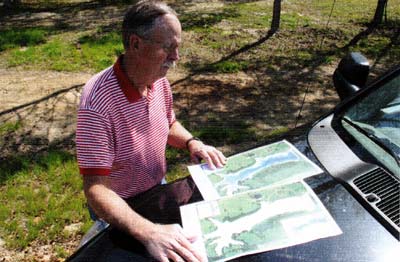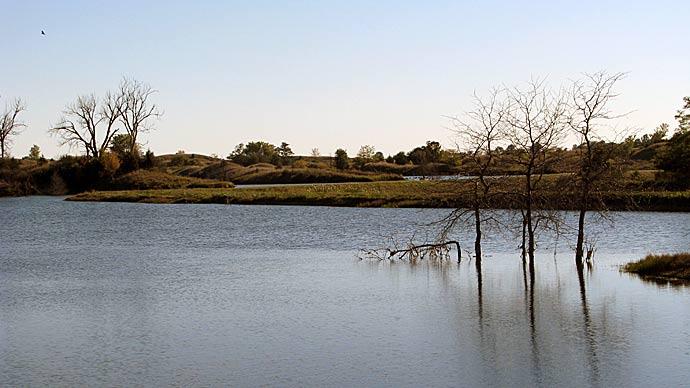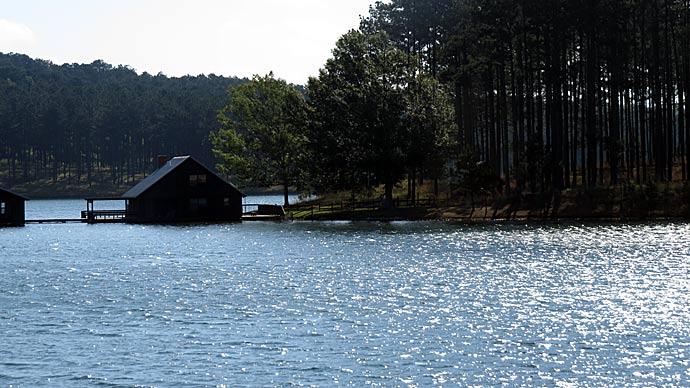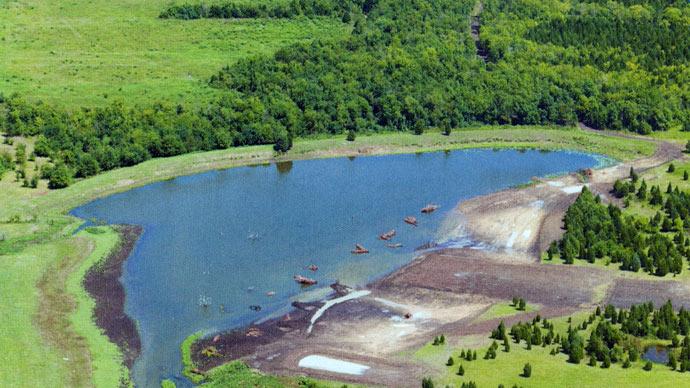
Never in my wildest adolescent junior high dreams did I ever think math would be such a massive deal for ponds. Going through the throes of learning algebra, geometry, and calculus...I equated all that stuff to the category of a simple box in my simple mind...from junior high through college.
Math. That's what it was, and I was convinced none played a significant role in my future as a fisheries biologist.
Boy, was I wrong.
If we don't understand geometry, how can we understand what it takes to build a dam? It's about angles, slopes, lengths, widths, and heights. Nowadays, I can at least understand the beginning volumes of dirt it might take to build a 600-foot dam that will average 12 feet tall with a 3 to 1 slope on both sides, plus a 12-foot crown on top so we can drive across it.
So, if we know the dam is 600 feet long, with an average dam height of 12 feet and a 3 to 1 slope, we look at it like a long triangle. If it's 12 feet tall, the bottom of that triangle must be 36 feet wide. Multiplying 600 x 12 x 36 gives us calculations for a long rectangle, but realizing the backside of the dam is a mirror of the front side, the calculation actually is for a long loaf-of-bread-shaped pile of dirt. So, multiplying it out, we have 259,200 cubic feet of dirt on top of the ground. Since dirt guys think in cubic yards, we divide that big number by 27 cubic feet per cubic yard and come up with 9,600 cubic yards of dirt for our starting point for our hypothetical dam. Add in the 600 feet x 12 feet x 12 feet wide crown, and we have another calculation. That's 86,400 cubic feet divided by 27 cubic feet per cubic yard, and we add another 3,200 cubic yards to our dirty little dam figures.

But wait, there's more.
We go to online maps now to calculate watershed size. We have to be able to read a topography map and then outline the area where water will flow toward our selected site.
More math.
For this hypothetical situation, say the watershed covers 120 acres. Our due diligence shows that the average annual rainfall (whatever that means nowadays) is about 48 inches. Now that we know the watershed size, we can calculate how much rainwater will roll toward our site. We can even have an educated guess of what the percentage of the runoff might be based on land use in the watershed. That's more math.
Now that we know the volume of water, we can get a reasonable estimate of how much water we'll need to impound, how big an overflow pipe needs to be, and how big the spillway needs to be.
That's math for engineers. Congrats, you now can relate to what a dam design engineer needs to know.

Now that we understand the watershed size, we can estimate how big this pond or lake should be to accommodate that volume of water.
More math.
One acre, one inch deep, is 27,000 gallons.
More math, but now you've figured out surface acreage and how many acre-feet of water can be stored in your coming-to-life pond design idea.
Guess what? More math is coming.
With that watershed size and the size of your dam, you've plotted a 14-acre lake. Next, you work with an earthmover to figure out the actual scope of the work. How many acres need to be cleared? That's about $3,000-4,000 per acre to clear it. What about the core trench? More dirt volume to figure out.
Get through that exercise, and now you are thinking about fish stocking.
You figure out your game plan with your consultant, biologist, fish supplier...someone you trust.
More math.
One thousand bluegills per surface acre at $.35 each times 14 acres. Do that with fathead minnows, redear sunfish, largemouth bass, channel catfish, or whatever species you decide. That extrapolates to biological odds for success as well as a budget.
Oh, and don't forget you'll weigh and measure some fish as you go and compare them to standard weights. More math.
So far, we've done some addition, subtraction, division, basic algebra, and some tidy tidbits of geometry.
Wait until it's time to determine how much fertilizer or herbicides you need to treat runaway aquatic plants.
That's a whole different set of ciphering.
Math makes your biology strong...pass it on!
Reprinted with permission from Pond Boss Magazine



